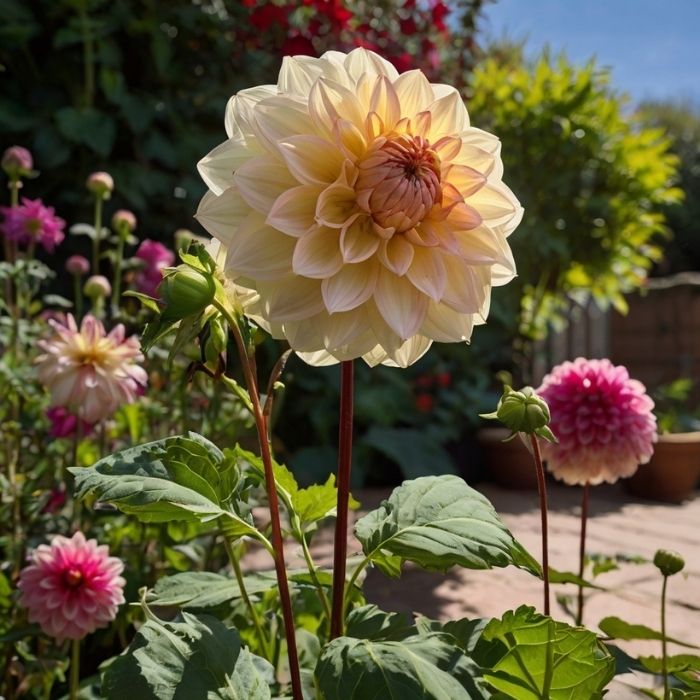The Beauty and Benefits of Dahlia Pinnata: A Complete Guide
Dahlias are among the most beloved flowers in the world, and Dahlia Pinnata stands out as one of the most iconic species in this genus. Known for its vibrant colors, intricate petal arrangements, and versatility in gardens, Dahlia Pinnata has captured the hearts of gardeners, florists, and flower enthusiasts alike. In this blog post, we’ll explore everything you need to know about this stunning plant—from its origins and characteristics to its cultivation tips and benefits.
What is Dahlia Pinnata?
Dahlia Pinnata, commonly referred to as the garden dahlia, is a species of flowering plant in the Asteraceae family. Native to Mexico, this plant was first discovered in the 16th century and has since become a global favorite. Its name honors the Swedish botanist Anders Dahl, and its species name, pinnata, refers to the pinnate (feather-like) structure of its leaves.
Dahlia Pinnata is renowned for its large, showy blooms that come in a wide range of colors, including red, pink, yellow, orange, purple, and white. The flowers can be single or double-petaled, with some varieties featuring intricate patterns and gradients. This diversity makes it a popular choice for gardens, floral arrangements, and even cultural celebrations.
The History and Cultural Significance of Dahlia Pinnata
Dahlia Pinnata has a rich history that dates back to the Aztec civilization. The Aztecs cultivated dahlias not only for their beauty but also for their practical uses. The tubers of the plant were used as a food source, while the flowers held symbolic meaning in religious ceremonies.
When Spanish explorers brought dahlias to Europe in the late 18th century, they quickly gained popularity as ornamental plants. Breeders began experimenting with hybridization, leading to the development of thousands of dahlia varieties we see today. Dahlia Pinnata, in particular, became a symbol of elegance and diversity in the floral world.
In modern times, dahlias are often associated with themes of inner strength, creativity, and change. They are frequently used in weddings, festivals, and garden displays, making them a timeless favorite.
Characteristics of Dahlia Pinnata
Dahlia Pinnata is a tuberous perennial plant that can grow up to 4 feet tall, depending on the variety. Here are some key characteristics that make it stand out:
- Flowers: The blooms of Dahlia Pinnata are its most striking feature. They can range from 2 to 10 inches in diameter and come in a variety of shapes, including pompon, cactus, and waterlily styles. The petals are often layered, creating a lush, full appearance.
- Leaves: The leaves are dark green, pinnate, and slightly serrated, giving the plant a lush, textured look even when not in bloom.
- Stems: The stems are sturdy and upright, making them ideal for cut flowers. They can support the weight of the large blooms without bending or breaking.
- Tubers: Like other dahlias, Dahlia Pinnata grows from tubers, which are underground storage organs. These tubers allow the plant to survive during dormant periods and regrow each spring.
How to Grow Dahlia Pinnata in Your Garden
Growing Dahlia Pinnata is a rewarding experience, but it requires some care and attention. Here’s a step-by-step guide to help you cultivate this beautiful plant:
1. Choose the Right Location
Dahlias thrive in full sunlight, so choose a spot in your garden that receives at least 6-8 hours of direct sunlight daily. The soil should be well-draining and rich in organic matter.
2. Planting the Tubers
Plant the tubers in spring, after the last frost has passed. Dig a hole about 6-8 inches deep and place the tuber horizontally with the eye (the growing point) facing upward. Space the tubers about 18-24 inches apart to allow room for growth.
3. Watering and Fertilizing
Water the plants regularly, keeping the soil moist but not waterlogged. Dahlias benefit from a balanced fertilizer applied every 4-6 weeks during the growing season.
4. Staking and Support
Tall varieties of Dahlia Pinnata may require staking to prevent the stems from bending or breaking under the weight of the flowers. Use bamboo stakes or garden supports to keep the plants upright.
5. Deadheading and Pruning
Remove spent flowers regularly to encourage continuous blooming. Prune any damaged or diseased foliage to maintain the plant’s health.
6. Overwintering
In colder climates, dig up the tubers after the first frost and store them in a cool, dry place until the next planting season.
Benefits of Dahlia Pinnata
Beyond its aesthetic appeal, Dahlia Pinnata offers several benefits:
- Pollinator Attraction: The bright, nectar-rich flowers attract bees, butterflies, and other pollinators, making them a valuable addition to any garden ecosystem.
- Cut Flowers: Dahlia Pinnata’s long stems and vibrant blooms make it a popular choice for floral arrangements. The flowers can last up to a week in a vase with proper care.
- Low Maintenance: Once established, Dahlia Pinnata is relatively easy to care for, requiring minimal maintenance compared to other ornamental plants.
- Cultural and Symbolic Value: Dahlias are often used in celebrations and ceremonies, symbolizing elegance, dignity, and creativity.
Common Challenges and Solutions
While Dahlia Pinnata is generally easy to grow, it can face a few challenges:
- Pests: Aphids, slugs, and spider mites can sometimes attack dahlias. Use organic pest control methods, such as neem oil or insecticidal soap, to keep these pests at bay.
- Diseases: Powdery mildew and root rot are common issues. Ensure proper spacing and air circulation to prevent fungal diseases, and avoid overwatering.
- Tuber Rot: Overwatering or poorly draining soil can cause tubers to rot. Plant in well-draining soil and water sparingly during dormant periods.
Fun Facts About Dahlia Pinnata
- Dahlias are the national flower of Mexico.
- There are over 42 species of dahlias and thousands of hybrids.
- Dahlia Pinnata was one of the first dahlia species introduced to Europe.
- The flowers are edible and can be used to garnish salads or desserts.
Conclusion
Dahlia Pinnata is a true gem in the world of flowering plants. Its stunning blooms, rich history, and versatility make it a must-have for any garden or floral arrangement. Whether you’re a seasoned gardener or a beginner, growing Dahlia flowers is a fulfilling experience that brings beauty and joy to your outdoor space.
By following the tips and guidelines outlined in this post, you can successfully cultivate and enjoy the splendor of Dahlia flowers in your own garden. So why wait? Add this magnificent plant to your collection and let its vibrant colors brighten up your world!

